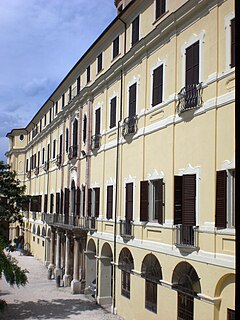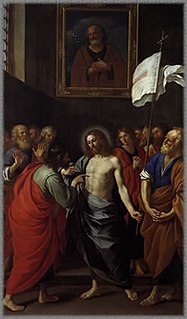Dino Ferrari was an Italian painter. He was born and died in Ascoli Piceno.

Carlo Cignani was an Italian painter. His innovative style referred to as his 'new manner' introduced a reflective, intimate mood of painting and presaged the later pictures of Guido Reni and Guercino, as well as those of Simone Cantarini. This gentle manner marked a break with the more energetic style of earlier Bolognese classicism of the Bolognese School of painting.

Antonio d'Enrico, called Tanzio da Varallo, or simply il Tanzio was an Italian painter of the late-Mannerist or early Baroque period.

The collections of the Pinacoteca Comunale di Cesena, in Cesena, Italy, contain works by:

Cesare Gennari was an Italian painter of the Baroque period. His Saint Mary Magdalene is in the Pinacoteca Civica di Cento. His Apparition of the Virgin to Saint Nicholas of Bari is at the Pinacoteca di Bologna.

The Palazzo Pianetti or Pianetti Tesei is a Rococo palace in the town of Jesi, region of Marche, Italy; it is presently used as the Civic Museum and exhibition space for Jesi.
The Pinacoteca Civica of Forlì, one of the civic museums of Forlì and currently based in the Musei di San Domenico, is an Italian art gallery. Artists whose work the gallery exhibits include:
Simone de Magistris was an Italian painter and sculptor.

Lorenzo Ottoni, also known as Lorenzo Ottone or Lorenzone, (1658–1736) was an Italian sculptor who was commissioned by the papacy and various noble houses of renaissance Italy.
Benedetto Gennari II was an Italian painter active during the Baroque period.
Antonio Coma (1560–1629) was an Italian composer. He was born in Cento, Ferrara, and came from a notable family of musicians. He may be the subject of a painting attributed to Guercino.

Bartolomeo Gennari was an Italian Renaissance painter.

Ercole Gennari was an Italian Renaissance drawer and painter.
Benedetto Zallone, or also called Zalone da Cento, (1595–1644) was an Italian painter of the Baroque period. He mainly painted religious subjects. He was born in Pieve di Cento. He was a pupil of Guercino. He worked in Rome and Cento. His name of Zalone was attributed to his appearance. In Cento, he painted a St Matthew and the Virgin for the church of San Agostino and St Gregory with Saints for San Pietro. Some of his works are now collected in the Pinacoteca of Pieve di Cento.
San Pietro is a Gothic style, Roman Catholic church located on Via Cremonino in Cento, Province of Ferrara, Region of Emilia-Romagna, Italy.
Giovanni Francesco Nagli was an Italian painter of the Baroque period. He was a follower of the style of Simone Cantarini and later of the prominent Baroque painter Guercino, who was born in Cento in what is now Emilia-Romagna. It for the latter reason that Nagli, as follower of Guercino, is called il Centino, despite being mostly active in Rimini from 1629 onward. He painted a Sant'Agostino at his desk, now in the Pinacoteca of Rimini. He painted a saint at the gallery of Cesena. He painted a Bambino killing a Dragon at San Francesco Saverio, Rimini. He painted an altarpiece depicting St Anthony of Padua preaching to the Fish,which was once the main altarpiece of the Church of the Theatines, Rimini
San Pietro in Valle is a baroque-style church located on Via Nolfi/Via San Francesco in the town of Fano, province of Pesaro and Urbino in the Marche region of Italy.











